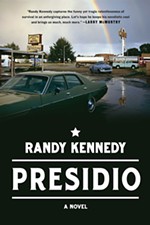They Drew Fire: Combat Artists of World War II
Brian Lanker
Reviewed by Jesse Sublett, Fri., Dec. 15, 2000

They Drew Fire: Combat Artists of World War II
by Brian Lanker and Nicole NewnhamTV Books, 192 pp., $39.95
Thanks to Saving Private Ryan and a tidal wave of tributes to the past century and its greatest moments, we seem to be inundated by books about World War II and the generation that fought it. One hopes that 50 years from now, our descendants won't be choking in a whirlwind of Desert Storm nostalgia. Of more timely interest, however, are the great many worthwhile books recently published about the war, many of which have been written by Stephen Ambrose, and a few that have not. For pure graphic impact, none compares to They Drew Fire: Combat Artists of World War II. The attractive, large-format book presents an astonishing perspective that has been little seen for the past half century. In fact, most of the original images in this book have been literally locked up in government archives since the end of the war. These vivid, often explosive images -- from on-the-spot foxhole and bunkhouse sketches to full-blown paintings -- are powerful, shocking reminders that photography and electronic media aren't necessarily the most effective media for communicating the immediacy of the moment; and that this may be particularly true when the subject is a raw, traumatic event like war.
This visual medium, which, notably, often presented the rarely seen color images from the war, also played a key role in the home-front war effort. Baby boomers and post-baby boomers, who grew up with propaganda-driven Hollywood films about the war, and who believe that Private Ryan was the first "realistic" depiction of the war, will probably be astonished at the pictures in They Drew Fire, which show the ugly, awful face of war with incredible power and realism. Army artists like Ed Reep, Manuel Bromberg, and Howard Brodie sent back pictures of soldiers huddled in bunkers or piled into a Jeep, looking like zombies, or a man tied to a post, dead (Brodie's Execution); these are not the heroic images we usually associate with World War II. Theo Hios' Ambush at Saipan seems to shoot flames off the page, with its primitive-style depiction of a close-quarters fight between soldiers using bayonets and sabres, with blood spouting from bodies, one side wearing uniforms painted a primary blue, the other bright yellow, the road behind them exploding in the same vibrant hue. There are plenty of heroic images, too; most of these seem more familiar, even at first glance. And there are wild, panoramic pictures, too, like Reep's Anzio Harbor, Benny's Death of the Shoho, and William Draper's The Landing -- which to my eyes suggest more detail and intimacy than photographic images of the war ever depicted. There's hardly a superfluous picture in the whole book. My own favorites are the paintings and drawings by the great Texas artist Tom Lea, the must-mentions including The Price, certainly one of the most hell-conjuring combat images of all time, and Two-Thousand Yard Stare gracing the cover, which uses the face of one G.I. to tell just about everything about a war there is to tell.
The most impressive thing about this sampling of the work of World War II combat artists is the sheer abundance of brutally honest reportage of the war, not to mention the sheer quality of it. A great many of the pictures emulate American artist Winslow Homer's classic illustrations from the Civil War. Others consciously paid tribute to Goya and other artists they admired. Some are more primitive, recalling Sam Chamberlain's primitive paintings of the Mexican War. "To hell with art," said artist Kerr Eby, "I made these for the Marines." By any measure, this is wonderful stuff. According to co-author Brian Lanker, more than 100 American combat artists worked to document the war, producing more than 12,000 paintings and drawings, the bulk of which were locked away in military archives after the war. The vast majority of the artists are dead, but Lanker and co-author Nicole Newnham tracked down a handful of the living ones to produce a documentary film, of which this book is a byproduct. Oral histories of seven of the artists are included in the book.
The bad news about They Drew Fire is that its documentary portions are shoddily written and organized, raising innumerable questions that are never answered, and are bound to cause a great deal of irritation to all but the most casual reader. The authors just do not seem up to the task of producing a coherent and credible historical chronicle. Specifically, the oral histories should have been edited more carefully for clarity. They Drew Fire is full of weird and inexcusable flaws and lapses of judgment, especially in its textual portions, but the sampling of the body of art the authors have nobly resurrected from obscurity, with its huge implications for both culture and history, makes They Drew Fire an essential American book, period. No collection should be without it. Really. And surely, one hopes, someday soon this material will pass into more capable hands.










